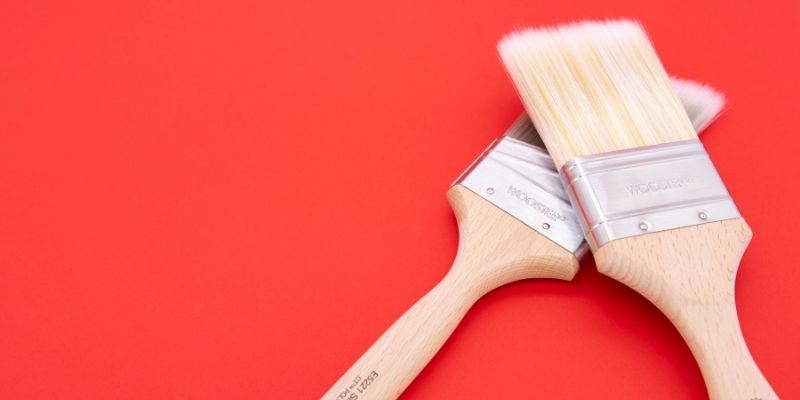The Ultimate Guide to Paint Rollers

Paint rollers are a staple when it comes to decorating and are used by almost every professional and DIY enthusiast to quickly paint large areas. The problem is there are so many roller frames and roller sleeve types available. In this article, we will look into the different types of roller sleeves and roller frames and what you can expect from each of them to help you discover which paint roller is right for you.
History of the paint roller
The humble paint roller is an everyday item but it started its life in Canada, invented in 1940 by Norman Breakey to assist in the hard work of painting. The first paint roller was a cylindrical core with a fabric cover that could soak up and distribute the paint.
Unfortunately, Norman was not able to manufacture the design at scale and other designers took the design and with a few tweaks mass-produced them, the most well know is that from Richard Croxton Adams, this was patented in 1940.
Now that we have a bit of history it's time to look at the modern-day paint rollers. Let's start with the paint roller frame itself.
Paint Roller Frames
Modern paint roller frames are available in a range of sizes and designs. The most common roller frame sizes are 4-inch, 9-inch, and 18-inch. These sizes are designed to match the roller sleeves that are used with the frame.
Although there are many different styles, the general design of the paint roller frame is the same. It consists of a handle, a bar, and the cage, handles are usually made from strong plastic, this makes them durable, lightweight and means they can be shaped to better fit your hand, however, brands such as Hamilton Decorating Tools do produce roller frames with wooden handles.
The bars on a roller frame come in two styles, American or British. The bar is a crucial part of the roller, if the bar is not rigid enough it can flex and cause the roller sleeve to apply uneven pressure giving a poor paint finish. The American style bar is more square with 90-degree bends, whereas the British design has a 45-degree bend after the bar leaves the handle. There is no specific reason for this and is just different designs.

With the handle this largely comes down to personal preference, some roller frames have rubber inlays to improve grip. Choosing a durable and comfortable handle is preferable as this will be the part of the frame that you have contact with.
When choosing a roller frame the cage design is vital to the quality of finish. Roller frames are available at various pricing brackets and the question we are often asked is, should I spend a bit more? The short answer to this is yes, but the answer is more complicated than that.
Roller frame cages are available in two diameters, 1.5 inches, and 1.75 inches. Most professional-grade roller frames have a 1.75-inch cage, this is to accommodate professional roller sleeves. When choosing a roller frame ensure the cage size matches the roller sleeve core. Cage designs differ from brand to brand, the more expensive versions also have features such as nylon bearings that prevent the cage from sticking when covered in paint as this can cause the roller to slide on the surface.
The most important thing to look for with any roller frame is a tight-fitting roller sleeve, If the roller sleeve doesn't fit the cage properly then it will cause the sleeve to slide off the cage as you are applying paint.
Paint Roller Sleeves
Now we've looked at the roller frame it's time to look at the sleeve or cover as it is sometimes known. Roller sleeves consist of a plastic core, usually nylon wrapped with material that is designed to absorb and distribute the paint. Roller covers come in a variety of materials and naps. The nap refers to the pile depth of the roller sleeve, the pile depth is important as choosing the right one for your surface will give you a better finish.
 Paint roller nap guide
Paint roller nap guide
Which roller sleeve do I need?
To decide which roller sleeve you need first you need to look at the surface that you are painting. If you are painting a freshly plastered surface, a short pile roller sleeve is ideal. The length of the pile is dependent on how smooth or rough the surface is, for example, a rougher, more uneven surface such as masonry will require a longer pile as the longer fibres help to get the paint to the lowest parts of the surface.
Roller sleeve materials vary also, there are natural lambswool roller sleeves that produce excellent results on masonry and uneven surfaces. This said, most modern roller sleeves are made from man-made materials such as microfibre. These modern materials hold more paint, are easier to clean, and shed less meaning they won't leave fibres on the painting surface.
Something to be aware of is the quality of the roller sleeve. Most professional-grade roller sleeves have the fibres heat fused to the core to prevent the roller material from unraveling during use. This can happen on some cheaper roller sleeves.
Mini Rollers
As well as 9-inch, 12-inch and 18-inch rollers there are also mini rollers. These rollers are ideal for smaller areas, doors and for cutting in to prevent a framing effect. This can happen when using a brush to cut in then a roller to fill in the large area.
Mini paint rollers are also ideal for painting behind radiators. Roller frames like the 27-inch Wooster Jumbo-Koter mini roller frame has an extra long bar to enable you to easily paint behind radiators without removing them from the wall.
These rollers also come with different ways of fitting the roller sleeve. The traditional design is a single bar that the roller sleeve pushes onto via a small tube through the roller sleeve. Brands such as Purdy and Wooster have their own mini cage that is similar to the larger frames. This makes for a more rigid roller and prevents the sleeve from sticking and slipping on the paint surface to give a high quality finish.

Mini-Roller types
These brands also make mini roller sleeves in two different sizes, these are 4.5-inch or 6.5-inch. The size is ultimately down to personal preference and the size of the area being painted. Most brands will sell mini rollers that are the exact same model and material as the larger models. This allows you to get exactly the same finish when using a mini roller to cut in.
Extension Poles
Painting large areas can be made easier by using an extension pole. These poles are usually adjustable and can either be screwed onto a roller frame , the higher quality frames and poles do come with specially designed quick release systems such as the Purdy Powerlock System. These systems are not interchangeable between brands but allow for roller frames to be changed quickly with a simple button press.
Using an extension pole is not just for hard to reach areas. Using an extension is helps to relieve strain on your back as you won't be bending to reach the bottom of the wall, it also helps to apply the paint more evenly as you can apply even pressure on the full stroke from top to bottom.
Conclusion
Paint rollers remain a staple for any decorator and choosing the right one is very much personal preference but taking the advice from this article can help you find the right roller for you.
Which roller will you choose?


